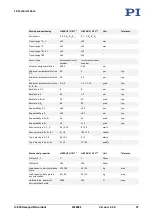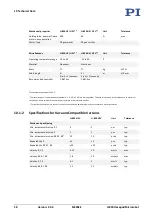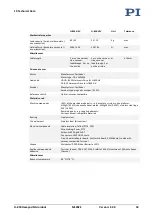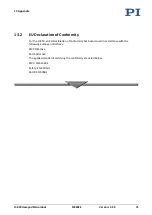
12 Glossary
H-850 Hexapod Microrobot
MS202E
Version: 2.3.0
69
User-defined coordinate system
Using the controller, custom coordinate systems can be defined and used instead of the default
coordinate systems.
Work with user-defined coordinate systems and the work-and-tool concept is described in the
C887T0007 technical note.
Workspace
The entirety of all combinations of translations and rotations that the hexapod can approach
from the current position is referred to as the workspace.
The workspace can be limited by the following external factors:
Installation space
Dimensions and position of the load
Center of rotation
The center of rotation describes the intersection of the rotational axes U, V, and W. When the
default settings for the coordinate system and the center of rotation are used, the center of
rotation after a reference move is located at the origin of the coordinate system (0,0,0), see the
dimensional drawing of the hexapod (p. 61).
The center of rotation always moves together with the platform.
Depending on the active --> operating coordinate system, the center of rotation can be moved
from the origin of the coordinate system in the X and/or Y and/or Z direction with the
SPI
command. The center of rotation that can be moved using the
SPI
command is also referred
to as "pivot point".
Hexapod system
The combination of hexapod, controller, cable set, and power supply is referred to as "hexapod
system" in this manual.
Default coordinate system
The X, Y, and Z axes of the Cartesian coordinate system are always spatially fixed, i.e., the
coordinate system does not move when the platform of the hexapod moves. The X, Y and Z
axes are also referred to as translational axes.
The intersection of the axes X, Y, and Z of the spatially fixed Cartesian coordinate system (0,0,0)
is referred to as the origin.
12
Glossary






























